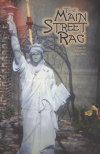Main Street Rag – Summer 2013
The Main Street Rag is published quarterly out of Charlotte, North Carolina. This issue opens with an interview with photographer Bryce Lankard, whose photos grace the cover and are included within the pages of text. The interview is a contemplative discussion of art and its purposes from Lankard’s point of view. His photos after Hurricane Katrina serve two purposes, “one to address the public debate and a second to address the loss.” He goes on to say that he “wanted to show New Orleans as flawed yet beautiful” and “remind people of the city’s cultural uniqueness and how rich it had been in providing the fabric of America—so the rest of the country would not abandon New Orleans.” His NOLA photographs accomplish these objectives. His 9/11 photographs reveal where the photographer was when the planes hit the towers and show life moving at an accustomed pace even in those moments. Lynda C. Ward’s interview illustrates Lankard’s passion and approach to the world.
The Main Street Rag is published quarterly out of Charlotte, North Carolina. This issue opens with an interview with photographer Bryce Lankard, whose photos grace the cover and are included within the pages of text. The interview is a contemplative discussion of art and its purposes from Lankard’s point of view. His photos after Hurricane Katrina serve two purposes, “one to address the public debate and a second to address the loss.” He goes on to say that he “wanted to show New Orleans as flawed yet beautiful” and “remind people of the city’s cultural uniqueness and how rich it had been in providing the fabric of America—so the rest of the country would not abandon New Orleans.” His NOLA photographs accomplish these objectives. His 9/11 photographs reveal where the photographer was when the planes hit the towers and show life moving at an accustomed pace even in those moments. Lynda C. Ward’s interview illustrates Lankard’s passion and approach to the world.
Poetry is in abundance in this issue, complete with narratives and imagery, characterizations and observations. Every poem in this issue is a work to be reckoned with, swallowed whole, and then dismantled to afford a closer look into its effectiveness. Many of the poems achieve greatness, and all aspire to it.
Alan Haider’s “Salesman” delivers an extended metaphor both chilling and profitable in the sense that readers profit from reading poetry that constructs as it tears down. From the speaker’s statement “I’m underwater without a tank,” the mood is set and the die is cast; no surprise that the poem ends with a corpse that won’t sink. A chilling view of capitalist culture.
A number of poems contain nature images that confound and inform, distress and delight. In “My Mother and the Wolves,” John Guzlowski reveals an image of an “adam’s apple / as if it were some mouse hidden / under a blanket of stubbled skin.” Kenneth Frost’s “One More Candle” begins:
My beagle dove
for a woodchuck
he cornered and
got a dirt hole
shoved in his face.
And David Radavich invites readers to contemplate “Climate Change” in which
Spring will burn
our nostrils
and the moon will turn
orange
before any fall
before any harvest.
A prediction that “If this is always, / we’re in trouble.” Frederick Pollack delivers a poetic narrative of a family sheltering from and surviving a storm in “Heartland,” in which “the sky blackens, and wind / shoves and pulls and howls in / all directions . . .” The imagery in every poem is stark and exact, beautiful and terrifying.
Poetry of relationship both to people and place also finds space in this issue. Lynn Pattison’s “Little Candy Shop of Heartache” promises “Every sweet // ache you ever tasted,” and delivers on that promise. In Timothy Geiger’s “I Had to be Taken” readers are presented with a story taking place in a seemingly small event in a teen son’s life as he’s driven to a basketball game that grows large from stanza to stanza. Geiger’s poem celebrates the nuance in each moment and conveys mood with each change of scene in which the speaker understands his father and his devotion. The layers of metaphor in the following lines should not be lost on any reader:
So he shifts to go back out, and when I also open my door
he stops me, grabbing my parka sleeve. He wants
to tell me to sit in the car, but instead says,
“Get to your thing,” and motions with a wet glove
toward the lights beyond the cemetery.
Reading these lines over and over is a satisfying experience in making contact with emotion through poetry. Symbolism is restrained yet powerful.
The poems highlighted here are just the tip of the poetry iceberg in this collection. Reading this issue of The Main Street Rag will be a journey of discovery through the high-quality poems that have been selected and showcased.
The four works of short fiction are an eclectic array of prose sprinkled throughout the poetic works. The standout is the longest story in the collection, “Stretch Marks” by Simone Martel, which weaves the narrator Ann’s past and present, examining who she is now compared to who she was as a girl of twelve. The common thread is the “famous artist-carpenter,” Phil, who belongs to both eras of Ann’s life, when she babysat for his child and in the present when she has hired him to build a fence. The remaining three stories have qualities that distinguish them one from the others if only by their settings: one set in the Greek islands, one in Tennessee, and one in the Caribbean. All tell stories worth the time.
This summer issue of The Main Street Rag holds poetic gems and inventive prose. The readers have the task of mining its resources to reach treasure.
[www.mainstreetrag.com]





